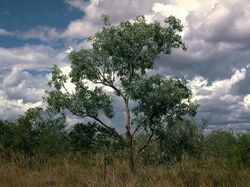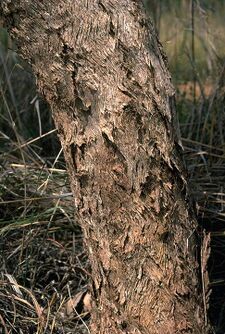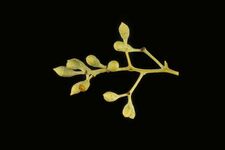Biology:Eucalyptus argillacea
| Mount House box | |
|---|---|

| |
| Eucalyptus argillacea near Mount Barnett Station | |
| Scientific classification | |
| Kingdom: | Plantae |
| Clade: | Tracheophytes |
| Clade: | Angiosperms |
| Clade: | Eudicots |
| Clade: | Rosids |
| Order: | Myrtales |
| Family: | Myrtaceae |
| Genus: | Eucalyptus |
| Species: | E. argillacea
|
| Binomial name | |
| Eucalyptus argillacea W.Fitzg.[2]
| |
Eucalyptus argillacea, commonly known as Mount House box,[3] or northern grey box[4] is a tree that is endemic to northern Australia . It has rough, fibrous bark, lance-shaped adult leaves, flower buds usually in groups of seven, creamy white flowers and conical fruit.
Description
Eucalyptus argillacea is a tree that typically grows to a height of 4 to 14 metres (13 to 46 ft) with rough, grey, fibrous bark on its trunk and branches. The adult leaves are elliptic to lance-shaped or egg-shaped, light green to greyish green, 50–140 mm (2.0–5.5 in) long and 7–35 mm (0.3–1 in) wide on a petiole 5–23 mm (0.20–0.91 in) long. The flower buds are arranged in groups of between three and seven on a peduncle 3–15 mm (0.1–0.6 in) long, the individual buds on a pedicel 2–5 mm (0.08–0.2 in) long. The mature buds are pear-shaped, oval or spindle-shaped, 6–10 mm (0.24–0.39 in) long and 4–6 mm (0.2–0.2 in) wide with a conical to beaked operculum 2–3 mm (0.079–0.12 in) long and 3–4 mm (0.12–0.16 in) wide. Flowering occurs from April to July or from October to December and the flowers are creamy white. The fruit is a conical capsule, 6–10 mm (0.24–0.39 in) long and 4–6 mm (0.16–0.24 in) wide.[3][5][6]
This species is similar to other box-type eucalypts found in tropical areas including E. tectifica, E. distans and E. obconica.[7]
Taxonomy and naming
Eucalyptus argillacea was first formally described in 1918 by William Vincent Fitzgerald and the description was publish in Joseph Maiden's book A Critical Revision of the Genus Eucalyptus from specimens collected by Fitzgerald in 1905 from around the base of Mount House.[8][9] The specific epithet (argillacea) is a Latin word meaning "clayey",[10] referring to the soil at the type location.[5]
Distribution and habitat
Mount House box is found along watercourses and on plains where it grows in alluvium and heavy clay soils. Populations are found only in the Kimberley region of Western Australia.[3][11] George M. Chippendale (1988) recognized its occurrence also in Northern Territory and northern Queensland, synonymizing E. leucophylla Domin[12] (now considered to be a separate taxon whose type locality is Queensland)[13] and citing specimens G.M. Chippendale 2171 (now its precise determination withdrawn),[14] R.E. Winkworth 1051, B. Hyland 6283 and L. Pedley 2056 (all of the last three currently re-determined as E. chlorophylla Brooker & Done).[15][16][17]
See also
References
- ↑ Fensham, R.; Collingwood, T.; Laffineur, B. (2019). "Eucalyptus argillacea". IUCN Red List of Threatened Species 2019: e.T133377919A133377921. doi:10.2305/IUCN.UK.2019-3.RLTS.T133377919A133377921.en. https://www.iucnredlist.org/species/133377919/133377921. Retrieved 20 September 2021.
- ↑ "Eucalyptus argillacea". Australian Plant Census. https://biodiversity.org.au/nsl/services/apc-format/display/95257.
- ↑ 3.0 3.1 3.2 "Eucalyptus argillacea". FloraBase. Western Australian Government Department of Parks and Wildlife. https://florabase.dpaw.wa.gov.au/browse/profile/5555.
- ↑ "Eucalyptus argillacea Northern Grey Box". Nindethana. https://www.nindethana.net.au/Product-Detail.aspx?p=947.
- ↑ 5.0 5.1 "Eucalyptus argillacea". Euclid: Centre for Australian National Biodiversity Research. http://keyserver.lucidcentral.org:8080/euclid/data/02050e02-0108-490e-8900-0e0601070d00/media/Html/Eucalyptus_argillacea.htm.
- ↑ Chippendale, George McCartney. "Eucalyptus argillacea". Australian Biological Resources Study, Department of the Environment and Energy, Canberra.. https://profiles.ala.org.au/opus/foa/profile/Eucalyptus%20argillacea.
- ↑ "Eucalyptus tectifica F.Muell.". NT Flora. Northern Territory Government. http://eflora.nt.gov.au/factsheet?id=3867.
- ↑ "Eucalyptus argillacea". APNI. https://id.biodiversity.org.au/instance/apni/455564.
- ↑ Maiden, Joseph (1918). A critical revision of the genus Eucalyptus (Volume 4). Sydney: Government Printer. pp. 132–133. https://www.biodiversitylibrary.org/item/100220#page/178/mode/1up. Retrieved 5 March 2019.
- ↑ Brown, Roland Wilbur (1956). The Composition of Scientific Words. Washington, D.C.: Smithsonian Institution Press. p. 100.
- ↑ Slee, A.V.; Brooker, M.I.H.; Duffy, S.M.; West, J.G. (2020). "Eucalyptus argillacea". EUCLID: Eucalypts of Australia (4th ed.). https://apps.lucidcentral.org/euclid/text/entities/eucalyptus_argillacea.htm. Retrieved 23 September 2022.
- ↑ Chippendale, G.M. (1988). "Eucalyptus". Flora of Australia. 19. Australian Covernment Publishing Service Canberra. p. 377. https://www.dcceew.gov.au/science-research/abrs/publications/flora-of-australia/vol19.
- ↑ Slee, A.V.; Brooker, M.I.H.; Duffy, S.M.; West, J.G. (2020). "Eucalyptus leucophylla". EUCLID: Eucalypts of Australia (4th ed.). https://apps.lucidcentral.org/euclid/text/entities/eucalyptus_leucophylla.htm. Retrieved 23 September 2022.
- ↑ Record: DNA A0002171 | Occurrence record | The Australian Virtual Herbarium. Accessed: 23 September 2022.
- ↑ Record: NSW 301114 | Occurrence record | The Australian Virtual Herbarium. Accessed: 23 September 2022.
- ↑ Record: BRI AQ0095823 | Occurrence record | The Australian Virtual Herbarium. Accessed: 23 September 2022.
- ↑ Record: BRI AQ0095807 | Occurrence record | The Australian Virtual Herbarium. Accessed: 23 September 2022.
Wikidata ☰ Q15397376 entry
 |




